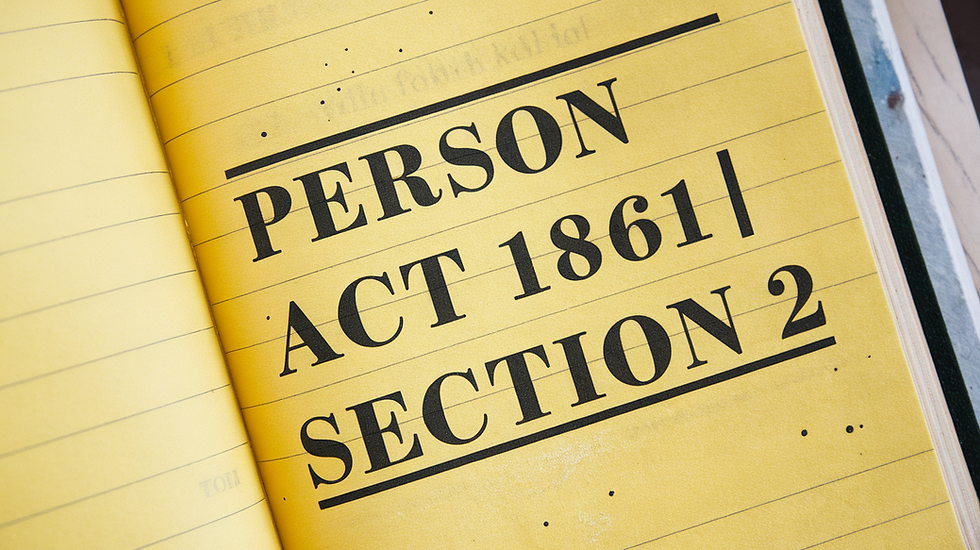Offences Against the Person Act 1861 | Section 1
- WLD Team

- 3 days ago
- 4 min read
The Offences Against the Person Act 1861 (OAPA 1861) is one of the most important pieces of criminal legislation in the United Kingdom. It sets out a wide range of offences involving violence, injury, and threats to individuals.
Although more than 160 years old, it remains a key legal text in criminal law. At the very start of the Act is Section 1, titled Saving for Murder.
While it is short, it plays an essential role: it confirms that the OAPA 1861 does not replace or limit the common law offence of murder. Without Section 1, there could be confusion about whether the Act redefined or replaced the law on murder.

Offences Against the Person Act 1861 Section 1 – The Text
Section 1 of the Offences Against the Person Act 1861 states:
“This Act shall not extend to murder, or to any manslaughter not expressly mentioned therein.”
This means:
The Act does not cover the crime of murder.
The Act does not cover manslaughter, unless specifically stated in another section.
Murder and manslaughter remain governed by common law and separate statutes.
Offences Against the Person Act 1861 Section 1 – Importance
Although it looks simple, Section 1 serves several purposes:
Clarity: It avoids any misunderstanding that murder is included in the offences listed in the Act.
Continuity of Common Law: Murder continues to be defined by common law, not statute.
Scope of the Act: It makes clear that the Act deals with other violent offences, such as assault, wounding, and poisoning, but not homicide.
Legal Certainty: It ensures lawyers, judges, and lawmakers know where the law on murder is found.
In short, Section 1 acts as a boundary line for the scope of the OAPA 1861.
Historical Context of Offences Against the Person Act 1861 Section 1
When the OAPA 1861 was passed, the law on homicide was already well established under common law. Parliament wanted to consolidate various statutes on violent offences without disturbing the separate and serious offence of murder.
Before 1861: Several earlier statutes dealt with specific forms of violence, but murder was always handled as a common law crime.
1861 Act: Parliament combined and updated many laws on assault and injury, but deliberately excluded murder.
After 1861: Murder continued to be prosecuted under common law until later reforms, such as the Homicide Act 1957.
Thus, Section 1 was necessary to preserve the traditional approach to homicide.
Offences Against the Person Act 1861 Section 1 – Relationship with Murder
Section 1 confirms that murder is not included in the OAPA 1861. Murder is instead defined by common law as:
“The unlawful killing of a human being under the Queen’s peace with malice aforethought.”
This means:
Murder remains separate from statutory offences in the OAPA 1861.
The definition and rules around murder come from judicial decisions, not this Act.
Manslaughter also remains outside the OAPA 1861, unless specifically referred to in sections on unlawful killing by negligence or dangerous acts.
Offences Against the Person Act 1861 Section 1 – Practical Example
Imagine a case where one person stabs another and causes death. Prosecutors must decide whether to charge:
Murder: If there was intent to kill or cause serious harm.
Manslaughter: If the killing was unlawful but without intent, such as through negligence.
Assault or Wounding (under OAPA 1861): If the victim survives.
Section 1 makes sure that if death occurs, the case is handled under murder or manslaughter law, not under the OAPA 1861’s other provisions.
Offences Against the Person Act 1861 Section 1 – Legal Significance Today
Even today, Section 1 remains relevant because:
Murder is still not defined by statute but by common law and later reforms.
Courts and legal practitioners use Section 1 as a reminder that OAPA 1861 does not touch the law of homicide.
Modern reforms have updated some parts of the OAPA 1861, but Section 1 has not been repealed.
This shows its enduring importance in setting boundaries in criminal law.
Conclusion
Section 1 of the Offences Against the Person Act 1861 may appear short and simple, but it carries great weight. By excluding murder and most forms of manslaughter from the scope of the Act, it preserves the common law approach to homicide.
It ensures that violent offences like assault, poisoning, and wounding are covered by the OAPA 1861, while the most serious crime of murder remains under separate legal principles.
Even today, Section 1 acts as a crucial guidepost for understanding how different offences fit within English criminal law.
FAQs
What does Section 1 of the Offences Against the Person Act 1861 say?
It states that the Act does not extend to murder or to any manslaughter not specifically mentioned in it.
Why was Section 1 included in the Act?
Section 1 was included to make clear that murder remained governed by common law and was not replaced or defined by this statute.
Does Section 1 affect manslaughter?
Yes. It excludes manslaughter unless specifically mentioned elsewhere in the Act, meaning most manslaughter cases are also handled outside the OAPA 1861.
Is murder defined in the Offences Against the Person Act 1861?
No. Murder is not defined in the Act. It is a common law offence, meaning its definition comes from court decisions.
Is Section 1 of the OAPA 1861 still relevant today?
Yes. Although many parts of the Act have been reformed, Section 1 still clarifies that murder and manslaughter are separate from the OAPA 1861.

Comments